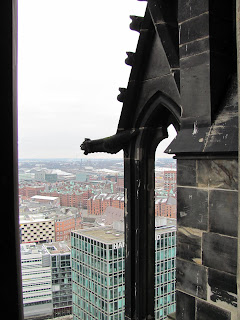
20 February 2012
What's Cooking?

The King's Architecture

 Christian IV is one of Denmark’s most infamous rulers. His passion for architecture changed the city skyline and as his style ornate brick and sandstone carving under a copper roof and elaborate spire can be seen throughout the city. While he succeeded in displaying his wealth and power to travelers and citizens alike, Denmark was nearly bankrupt at the end of his rule.
Christian IV is one of Denmark’s most infamous rulers. His passion for architecture changed the city skyline and as his style ornate brick and sandstone carving under a copper roof and elaborate spire can be seen throughout the city. While he succeeded in displaying his wealth and power to travelers and citizens alike, Denmark was nearly bankrupt at the end of his rule.For example, the stock exchange:
16 February 2012
Day 3
Memory sites of Downtown Hamburg:
WWI memorial intended to propagate nationalism for WWII:

A more humanizing counter monument:


Hamburg was almost completely destroyed by a week of firebombing in WWII. However, the St. Nicholas Church tower still stands. We were able to take an elevator to the top and see the rebuilt city.


 More Hamburg:
More Hamburg:

Day 2
To begin the day, we were treated to the best continental breakfast I have ever had: eggs, bacon, sausage, fried tomatoes, breads, but also smoked salmon, meats, spreads. Once fully charged, we went to Duborg Skolen, a Danish emersion school in Flensburg, Germany. The students have class in Danish and speak either Danish or German at home but use a hybrid when communicating with friends. The majority aspire to attend university in Denmark where education is free and the government gives students a stipend. However, they feel most comfortable in Flensburg, where their duel identity is accepted. One student sees the value of the German mentality, a stricter, more disciplined way of life in combination with the relaxed Danish mentality. “Sometimes you need both things, that’s why I choose both things.”
 Exploring Flensborg:
Exploring Flensborg:

We made it to Hamburg by evening in time for a tour of the St. Pauli district in relation to WWII. Once we were set free, a group of us went to a lively Greek restaurant for dinner. On our way out, the owner’s sister told us we couldn’t be in Hamburg without seeing the Reeperbahn, the red light district of the city. I won’t go into details, but I’ve never been anything quite like it.

Short Study Tour, Day 1
I spent the weekend in Germany for the short study tour associated with my core course, European Memory and Identity. It was great to get acquainted with my classmates in a more relaxed setting as well as learn about the significance of the German/Danish border region.
First stop: Dybbøl Banke, the battlefield on which Denmark lost the War of 1864, losing 1/3 of its land and population to Austria/Prussia. It became a turning point for Danish policy as the focus shifted to internal affairs, thus beginning the welfare society. Today, Dybbøl is symbolic of nationalistic pride for the Danes.

Next we went to Frøslev/Fårhus Concentration Camp/Frøslevlejren. During WWII, Germany and Denmark were never officially at war because an ultimatum was signed allowing the Danish government to remain in power in exchange for a peaceful occupation. When a few hundred Danes were sent to German Concentration Camps, the Danish government proposed an internment camp on Danish soil. Unlike many camps of WWII, Frøslev was not a death camp. There was little violence and, with the Danish Prison Authority in charge of feeding the prisoners, little starvation.
The less told story is that of Fårhus, a state prison for Danes and Germans convicted of SS military service. This camp was maintained by the resistance, many of whom had been prisoners at Frøslev, and operated from May 1945 to 1949 when the prisoners were pardoned as Europe began to come to terms with the past.

07 February 2012
Sneen!


A Weekend of Cultural Exchange: Food

The jar of peanut butter is even decorated in American patriotism, as is the slightly less appealing pre packaged cheeseburger:
 Traditional Danish hotdog (complete with mustard, ketchup, fried onion, and pickles):
Traditional Danish hotdog (complete with mustard, ketchup, fried onion, and pickles):
02 February 2012
Spears, Abbey, and Ale, Oh my!
 Nowadays, it is a restaurant and site of medieval fighting reenactments. So we divided into teams to see which warriors were the fiercest and would aid the king on his quest (or so the story goes). Team Rowdy Rooster (and our time traveling friends):
Nowadays, it is a restaurant and site of medieval fighting reenactments. So we divided into teams to see which warriors were the fiercest and would aid the king on his quest (or so the story goes). Team Rowdy Rooster (and our time traveling friends):

 After jousting, stick fighting, ladder climbing, rock lifting, catapulting cabbage, and lots of war cries (Cock-a-doodle-doo!), we were exhausted and ready for refreshment. The points were tallied and the winner announced. First place…. The Rowdy Roosters (but I know you all expected that knowing the ferocity of the team captain)!
After jousting, stick fighting, ladder climbing, rock lifting, catapulting cabbage, and lots of war cries (Cock-a-doodle-doo!), we were exhausted and ready for refreshment. The points were tallied and the winner announced. First place…. The Rowdy Roosters (but I know you all expected that knowing the ferocity of the team captain)!




